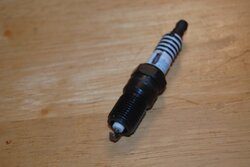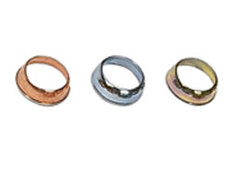aldive
Elite In Memoriam
- Joined
- January 17, 2001
- Messages
- 24,667
- Reaction score
- 28
- Year, Model & Trim Level
- 1999 XLT
In my inexhaustible pursuit of superior gas mileage (http://www.explorerforum.com/forums/showthread.php?t=44372&highlight=quest ) I have made many mods to my truck, some performed well while some did not. I recently decided to give an old racer’s trick an evaluation on my ’99 4.0 SOHC (http://www.explorerforum.com/forums/showthread.php?t=137531 ). The trick is indexing the spark plugs.
Pray tell, what is this indexing? In essence, the concept of indexing is to orient the spark plug so the gap is facing the center of the cylinder, slightly toward the intake valve ( some say toward the exhaust valve ). The logic is, as the piston approaches top dead center, the air/fuel charge is being compressed. The air/fuel charge is accelerated toward the area of the spark plug. Consequently, the spark emanating from the plug should be orientated to create the best possible flame front. When viewing our Explorer’s side-gap spark plug, one will observe the electrode can actually block the flame process. Conversely, if the electrode gap faces the advancing air/fuel charge, it stands a improved chance of optimally igniting a flame front.
My interest in this venture is the theoretical boost in gas mileage due to a more efficient ignition process; the increase in HP, albeit small, is a welcomed windfall.
Indexing the spark plugs is a time consuming and tedious task. Is it worth it? We shall see in the upcoming week. Remember, since my interest in this project is strictly gas mileage, consequently, a before and after dyno test will not be conducted.
I used indexing washers to align the plugs. These are soft copper washers of various thicknesses ( 0.010'', 0.021'', 0.032'' ).
The first step in the indexing process is to make a mark on the spark plug ceramic with a black Magic Marker, oriented with the gap. After installing the plugs ( to 10 ft pounds ) and noting the position of the mark, the plugs were removed and indexing washers of varying thickness ( trial and error ) were added to allow the gap to point in the desired location. This was accomplished by adding. The plugs were tightened to 10 ft pounds and the location of the index mark checked for position. Perfect alignment evaded me, but it was close enough for government work.
This project took about 2 1/2 hours and was a major pain in the arse, however, the only cost was the indexing washers Moroso (http://www.moroso.com/default.asp ) 71900 - Spark Plug Indexing Washers
Obtained from Jegs [ http://www.jegs.com/webapp/wcs/stores/servlet/product_10001_10002_39232_-1 ] for $15.99 and of course my time.
Upon cranking there was no difference in start up or idling compared to conditions prior to indexing. A test drive through the neighborhood showed no power difference nor was any expected. A 40 mile highway run confirmed.
A road trip to Atlanta is scheduled in a few days during which gas mileage data will be compiled. The numbers shall be reported on my return.
Pray tell, what is this indexing? In essence, the concept of indexing is to orient the spark plug so the gap is facing the center of the cylinder, slightly toward the intake valve ( some say toward the exhaust valve ). The logic is, as the piston approaches top dead center, the air/fuel charge is being compressed. The air/fuel charge is accelerated toward the area of the spark plug. Consequently, the spark emanating from the plug should be orientated to create the best possible flame front. When viewing our Explorer’s side-gap spark plug, one will observe the electrode can actually block the flame process. Conversely, if the electrode gap faces the advancing air/fuel charge, it stands a improved chance of optimally igniting a flame front.
My interest in this venture is the theoretical boost in gas mileage due to a more efficient ignition process; the increase in HP, albeit small, is a welcomed windfall.
Indexing the spark plugs is a time consuming and tedious task. Is it worth it? We shall see in the upcoming week. Remember, since my interest in this project is strictly gas mileage, consequently, a before and after dyno test will not be conducted.
I used indexing washers to align the plugs. These are soft copper washers of various thicknesses ( 0.010'', 0.021'', 0.032'' ).
The first step in the indexing process is to make a mark on the spark plug ceramic with a black Magic Marker, oriented with the gap. After installing the plugs ( to 10 ft pounds ) and noting the position of the mark, the plugs were removed and indexing washers of varying thickness ( trial and error ) were added to allow the gap to point in the desired location. This was accomplished by adding. The plugs were tightened to 10 ft pounds and the location of the index mark checked for position. Perfect alignment evaded me, but it was close enough for government work.
This project took about 2 1/2 hours and was a major pain in the arse, however, the only cost was the indexing washers Moroso (http://www.moroso.com/default.asp ) 71900 - Spark Plug Indexing Washers
Obtained from Jegs [ http://www.jegs.com/webapp/wcs/stores/servlet/product_10001_10002_39232_-1 ] for $15.99 and of course my time.
Upon cranking there was no difference in start up or idling compared to conditions prior to indexing. A test drive through the neighborhood showed no power difference nor was any expected. A 40 mile highway run confirmed.
A road trip to Atlanta is scheduled in a few days during which gas mileage data will be compiled. The numbers shall be reported on my return.













